Moroccan vs Liberian Community Comparison
COMPARE
Moroccan
Liberian
Social Comparison
Social Comparison
Moroccans
Liberians
3,626
SOCIAL INDEX
33.8/ 100
SOCIAL RATING
215th/ 347
SOCIAL RANK
1,824
SOCIAL INDEX
15.8/ 100
SOCIAL RATING
286th/ 347
SOCIAL RANK
Liberian Integration in Moroccan Communities
The statistical analysis conducted on geographies consisting of 85,109,664 people shows a weak positive correlation between the proportion of Liberians within Moroccan communities in the United States with a correlation coefficient (R) of 0.254. On average, for every 1% (one percent) increase in Moroccans within a typical geography, there is an increase of 0.094% in Liberians. To illustrate, in a geography comprising of 100,000 individuals, a rise of 1,000 Moroccans corresponds to an increase of 94.4 Liberians.
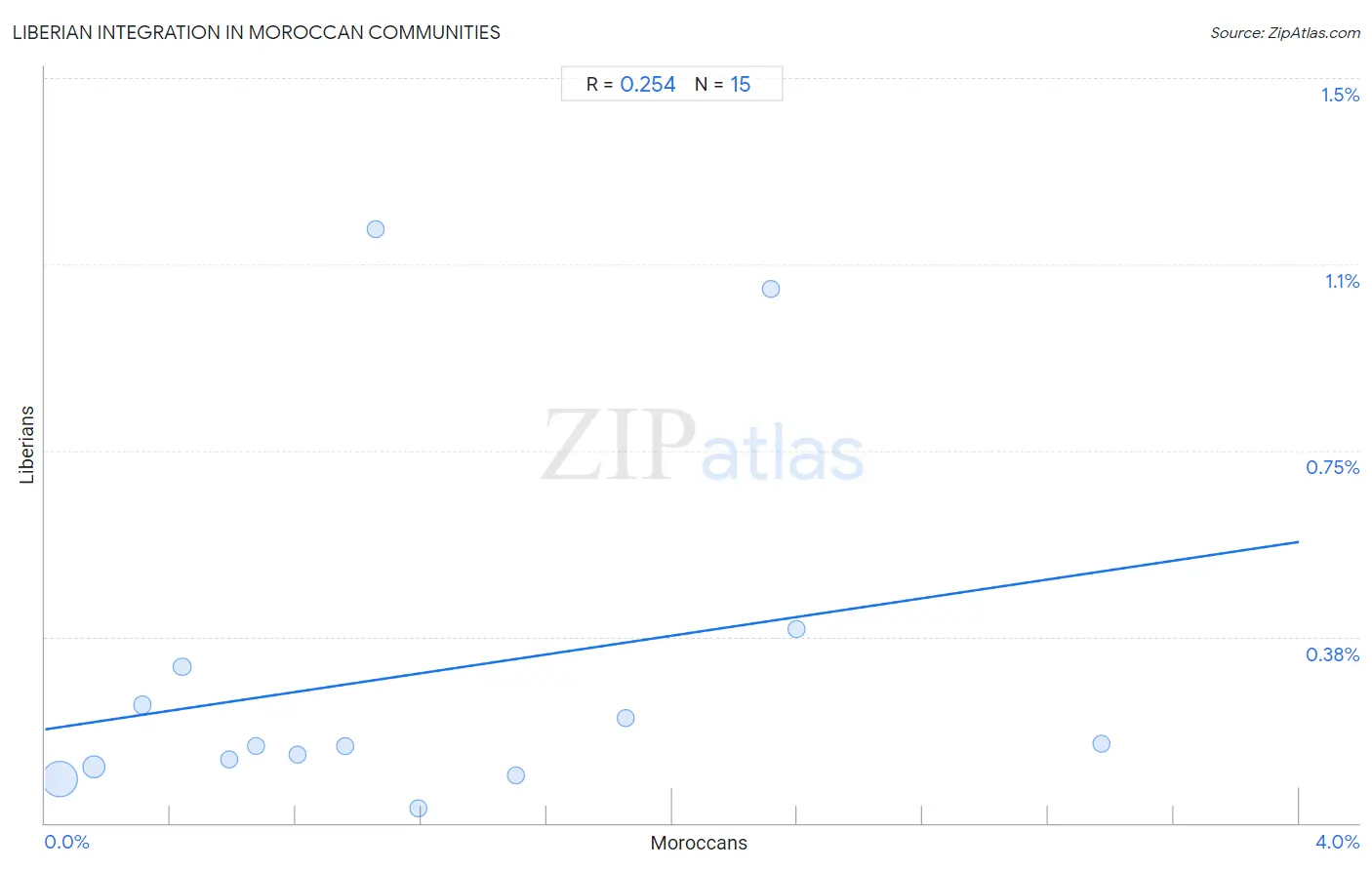
Moroccan vs Liberian Income
When considering income, the most significant differences between Moroccan and Liberian communities in the United States are seen in per capita income ($45,854 compared to $38,780, a difference of 18.2%), householder income ages 25 - 44 years ($96,117 compared to $82,005, a difference of 17.2%), and median male earnings ($56,499 compared to $49,318, a difference of 14.6%). Conversely, both communities are more comparable in terms of householder income under 25 years ($53,256 compared to $48,917, a difference of 8.9%), median female earnings ($41,872 compared to $38,215, a difference of 9.6%), and householder income over 65 years ($59,683 compared to $54,356, a difference of 9.8%).

| Income Metric | Moroccan | Liberian |
| Per Capita Income | Exceptional $45,854 | Tragic $38,780 |
| Median Family Income | Good $104,488 | Tragic $91,722 |
| Median Household Income | Good $86,468 | Tragic $75,667 |
| Median Earnings | Exceptional $48,838 | Tragic $43,536 |
| Median Male Earnings | Excellent $56,499 | Tragic $49,318 |
| Median Female Earnings | Exceptional $41,872 | Tragic $38,215 |
| Householder Age | Under 25 years | Exceptional $53,256 | Tragic $48,917 |
| Householder Age | 25 - 44 years | Good $96,117 | Tragic $82,005 |
| Householder Age | 45 - 64 years | Average $100,138 | Tragic $88,929 |
| Householder Age | Over 65 years | Fair $59,683 | Tragic $54,356 |
| Wage/Income Gap | Exceptional 24.0% | Exceptional 21.4% |
Moroccan vs Liberian Poverty
When considering poverty, the most significant differences between Moroccan and Liberian communities in the United States are seen in receiving food stamps (12.8% compared to 14.8%, a difference of 16.0%), child poverty among girls under 16 (17.8% compared to 19.9%, a difference of 11.6%), and child poverty under the age of 16 (17.6% compared to 19.5%, a difference of 10.7%). Conversely, both communities are more comparable in terms of single male poverty (12.9% compared to 13.0%, a difference of 0.72%), female poverty among 18-24 year olds (20.4% compared to 20.6%, a difference of 1.2%), and single mother poverty (29.5% compared to 29.9%, a difference of 1.3%).
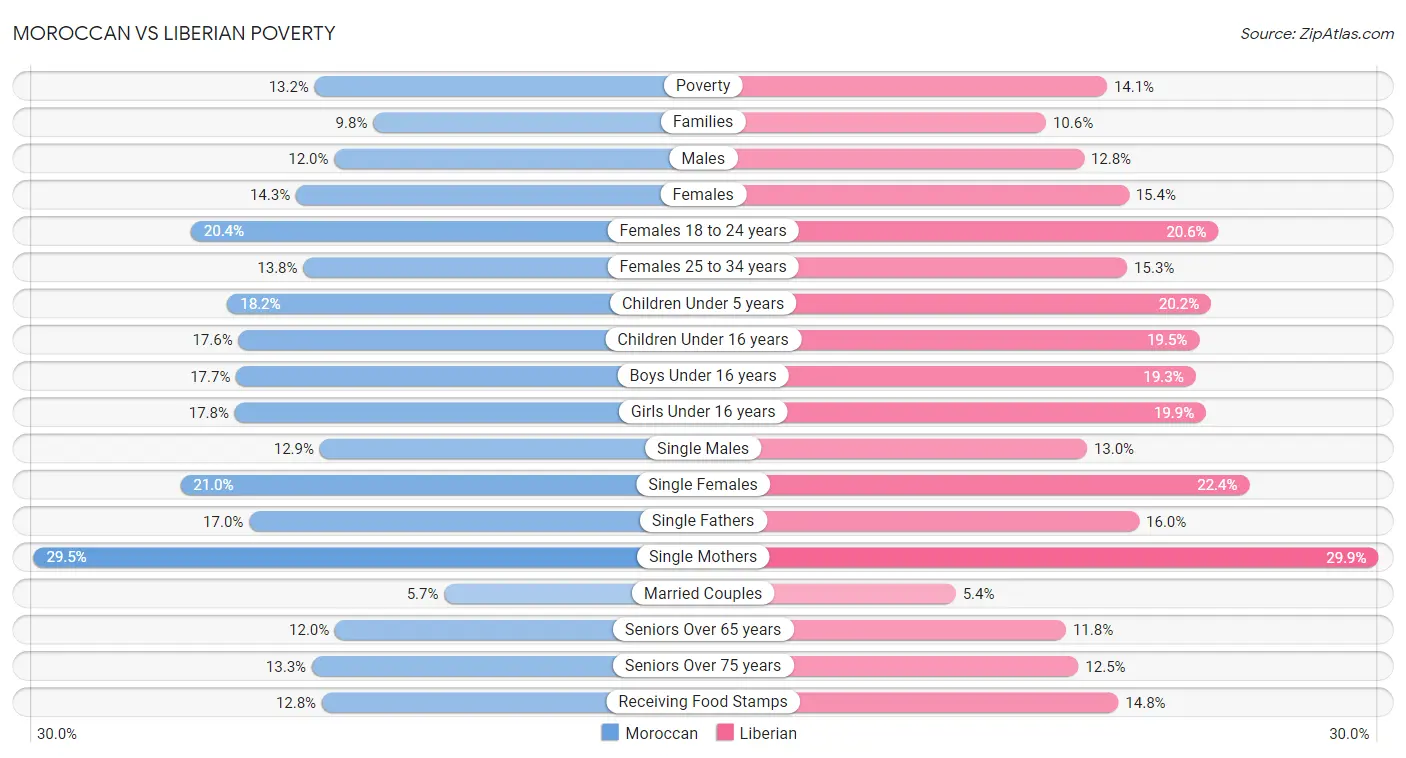
| Poverty Metric | Moroccan | Liberian |
| Poverty | Tragic 13.2% | Tragic 14.1% |
| Families | Tragic 9.8% | Tragic 10.6% |
| Males | Tragic 12.0% | Tragic 12.8% |
| Females | Tragic 14.3% | Tragic 15.4% |
| Females 18 to 24 years | Fair 20.4% | Poor 20.6% |
| Females 25 to 34 years | Fair 13.8% | Tragic 15.3% |
| Children Under 5 years | Tragic 18.2% | Tragic 20.2% |
| Children Under 16 years | Tragic 17.6% | Tragic 19.5% |
| Boys Under 16 years | Tragic 17.7% | Tragic 19.3% |
| Girls Under 16 years | Tragic 17.8% | Tragic 19.9% |
| Single Males | Fair 12.9% | Fair 13.0% |
| Single Females | Average 21.0% | Tragic 22.4% |
| Single Fathers | Tragic 17.0% | Excellent 16.0% |
| Single Mothers | Fair 29.5% | Poor 29.9% |
| Married Couples | Tragic 5.7% | Fair 5.4% |
| Seniors Over 65 years | Tragic 12.0% | Tragic 11.8% |
| Seniors Over 75 years | Tragic 13.3% | Fair 12.5% |
| Receiving Food Stamps | Tragic 12.8% | Tragic 14.8% |
Moroccan vs Liberian Unemployment
When considering unemployment, the most significant differences between Moroccan and Liberian communities in the United States are seen in unemployment among seniors over 75 years (7.8% compared to 10.2%, a difference of 30.9%), unemployment among women with children ages 6 to 17 years (8.9% compared to 10.8%, a difference of 21.5%), and unemployment among ages 60 to 64 years (4.9% compared to 4.5%, a difference of 8.8%). Conversely, both communities are more comparable in terms of female unemployment (5.5% compared to 5.5%, a difference of 0.21%), unemployment among ages 55 to 59 years (5.0% compared to 5.1%, a difference of 0.36%), and unemployment among ages 20 to 24 years (10.7% compared to 10.8%, a difference of 1.3%).
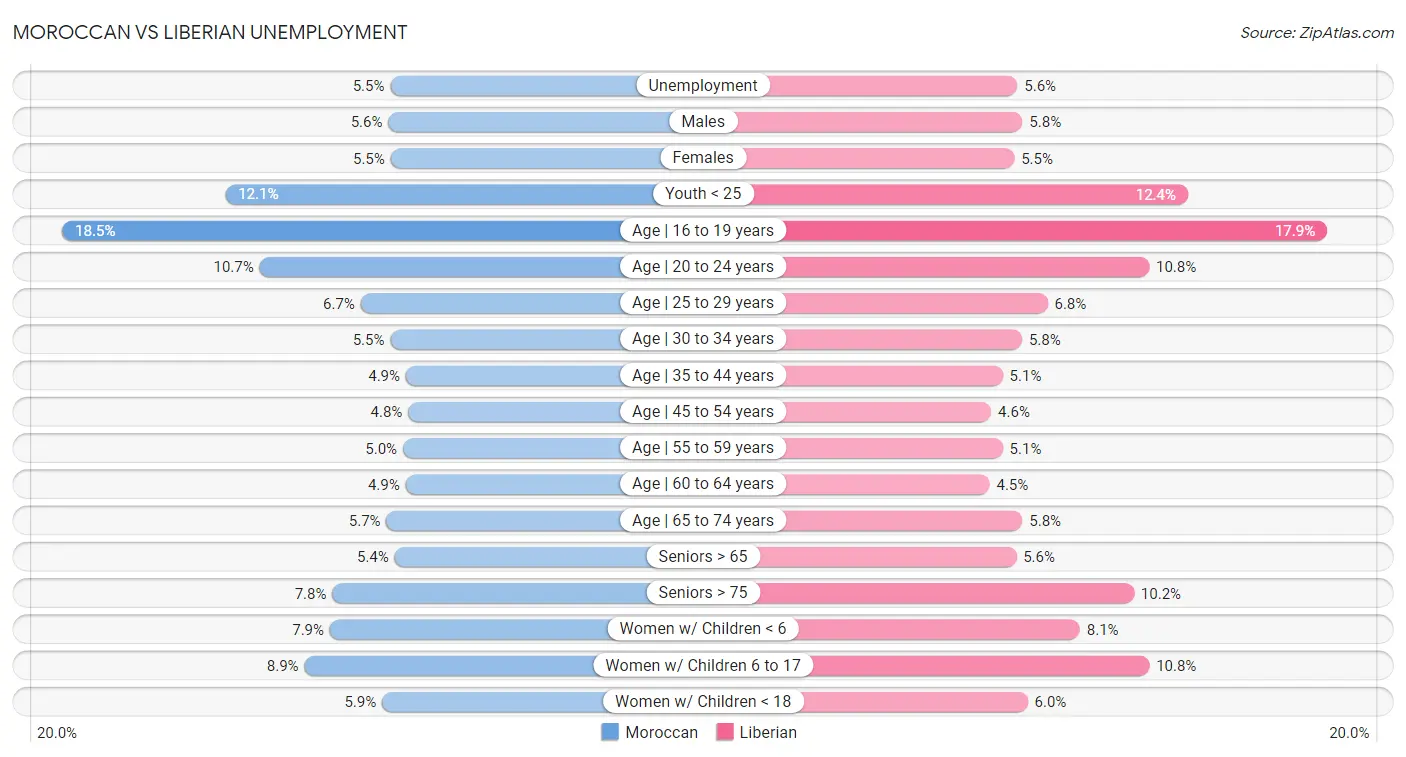
| Unemployment Metric | Moroccan | Liberian |
| Unemployment | Tragic 5.5% | Tragic 5.6% |
| Males | Tragic 5.6% | Tragic 5.8% |
| Females | Tragic 5.5% | Tragic 5.5% |
| Youth < 25 | Tragic 12.1% | Tragic 12.4% |
| Age | 16 to 19 years | Tragic 18.5% | Poor 17.9% |
| Age | 20 to 24 years | Tragic 10.7% | Tragic 10.8% |
| Age | 25 to 29 years | Fair 6.7% | Poor 6.8% |
| Age | 30 to 34 years | Fair 5.5% | Tragic 5.8% |
| Age | 35 to 44 years | Tragic 4.9% | Tragic 5.1% |
| Age | 45 to 54 years | Tragic 4.8% | Poor 4.6% |
| Age | 55 to 59 years | Tragic 5.0% | Tragic 5.1% |
| Age | 60 to 64 years | Poor 4.9% | Exceptional 4.5% |
| Age | 65 to 74 years | Tragic 5.7% | Tragic 5.8% |
| Seniors > 65 | Tragic 5.4% | Tragic 5.6% |
| Seniors > 75 | Exceptional 7.8% | Tragic 10.2% |
| Women w/ Children < 6 | Tragic 7.9% | Tragic 8.1% |
| Women w/ Children 6 to 17 | Average 8.9% | Tragic 10.8% |
| Women w/ Children < 18 | Tragic 5.9% | Tragic 6.0% |
Moroccan vs Liberian Labor Participation
When considering labor participation, the most significant differences between Moroccan and Liberian communities in the United States are seen in in labor force | age 16-19 (35.7% compared to 41.8%, a difference of 17.2%), in labor force | age 20-24 (74.7% compared to 78.0%, a difference of 4.4%), and in labor force | age > 16 (66.1% compared to 67.8%, a difference of 2.6%). Conversely, both communities are more comparable in terms of in labor force | age 45-54 (82.5% compared to 83.0%, a difference of 0.72%), in labor force | age 20-64 (79.7% compared to 80.9%, a difference of 1.5%), and in labor force | age 35-44 (84.2% compared to 85.7%, a difference of 1.7%).

| Labor Participation Metric | Moroccan | Liberian |
| In Labor Force | Age > 16 | Exceptional 66.1% | Exceptional 67.8% |
| In Labor Force | Age 20-64 | Good 79.7% | Exceptional 80.9% |
| In Labor Force | Age 16-19 | Poor 35.7% | Exceptional 41.8% |
| In Labor Force | Age 20-24 | Fair 74.7% | Exceptional 78.0% |
| In Labor Force | Age 25-29 | Fair 84.5% | Exceptional 86.1% |
| In Labor Force | Age 30-34 | Average 84.6% | Exceptional 86.4% |
| In Labor Force | Age 35-44 | Fair 84.2% | Exceptional 85.7% |
| In Labor Force | Age 45-54 | Poor 82.5% | Excellent 83.0% |
Moroccan vs Liberian Family Structure
When considering family structure, the most significant differences between Moroccan and Liberian communities in the United States are seen in single mother households (6.6% compared to 8.6%, a difference of 31.3%), births to unmarried women (31.8% compared to 37.4%, a difference of 17.6%), and single father households (2.2% compared to 2.5%, a difference of 14.4%). Conversely, both communities are more comparable in terms of family households (61.9% compared to 62.0%, a difference of 0.090%), average family size (3.22 compared to 3.25, a difference of 0.77%), and divorced or separated (12.1% compared to 12.6%, a difference of 3.5%).

| Family Structure Metric | Moroccan | Liberian |
| Family Households | Tragic 61.9% | Tragic 62.0% |
| Family Households with Children | Tragic 26.9% | Exceptional 28.3% |
| Married-couple Households | Tragic 43.5% | Tragic 40.7% |
| Average Family Size | Average 3.22 | Excellent 3.25 |
| Single Father Households | Exceptional 2.2% | Tragic 2.5% |
| Single Mother Households | Poor 6.6% | Tragic 8.6% |
| Currently Married | Tragic 44.6% | Tragic 42.2% |
| Divorced or Separated | Fair 12.1% | Tragic 12.6% |
| Births to Unmarried Women | Average 31.8% | Tragic 37.4% |
Moroccan vs Liberian Vehicle Availability
When considering vehicle availability, the most significant differences between Moroccan and Liberian communities in the United States are seen in no vehicles in household (14.7% compared to 12.0%, a difference of 22.5%), 3 or more vehicles in household (15.9% compared to 17.0%, a difference of 7.0%), and 4 or more vehicles in household (4.9% compared to 5.3%, a difference of 6.9%). Conversely, both communities are more comparable in terms of 1 or more vehicles in household (85.4% compared to 88.0%, a difference of 3.1%), 2 or more vehicles in household (48.8% compared to 51.7%, a difference of 6.0%), and 4 or more vehicles in household (4.9% compared to 5.3%, a difference of 6.9%).

| Vehicle Availability Metric | Moroccan | Liberian |
| No Vehicles Available | Tragic 14.7% | Tragic 12.0% |
| 1+ Vehicles Available | Tragic 85.4% | Tragic 88.0% |
| 2+ Vehicles Available | Tragic 48.8% | Tragic 51.7% |
| 3+ Vehicles Available | Tragic 15.9% | Tragic 17.0% |
| 4+ Vehicles Available | Tragic 4.9% | Tragic 5.3% |
Moroccan vs Liberian Education Level
When considering education level, the most significant differences between Moroccan and Liberian communities in the United States are seen in professional degree (5.0% compared to 3.6%, a difference of 39.4%), doctorate degree (2.0% compared to 1.5%, a difference of 32.4%), and master's degree (16.8% compared to 12.8%, a difference of 30.6%). Conversely, both communities are more comparable in terms of 6th grade (96.8% compared to 96.8%, a difference of 0.020%), 11th grade (92.3% compared to 92.3%, a difference of 0.020%), and 5th grade (97.1% compared to 97.0%, a difference of 0.090%).
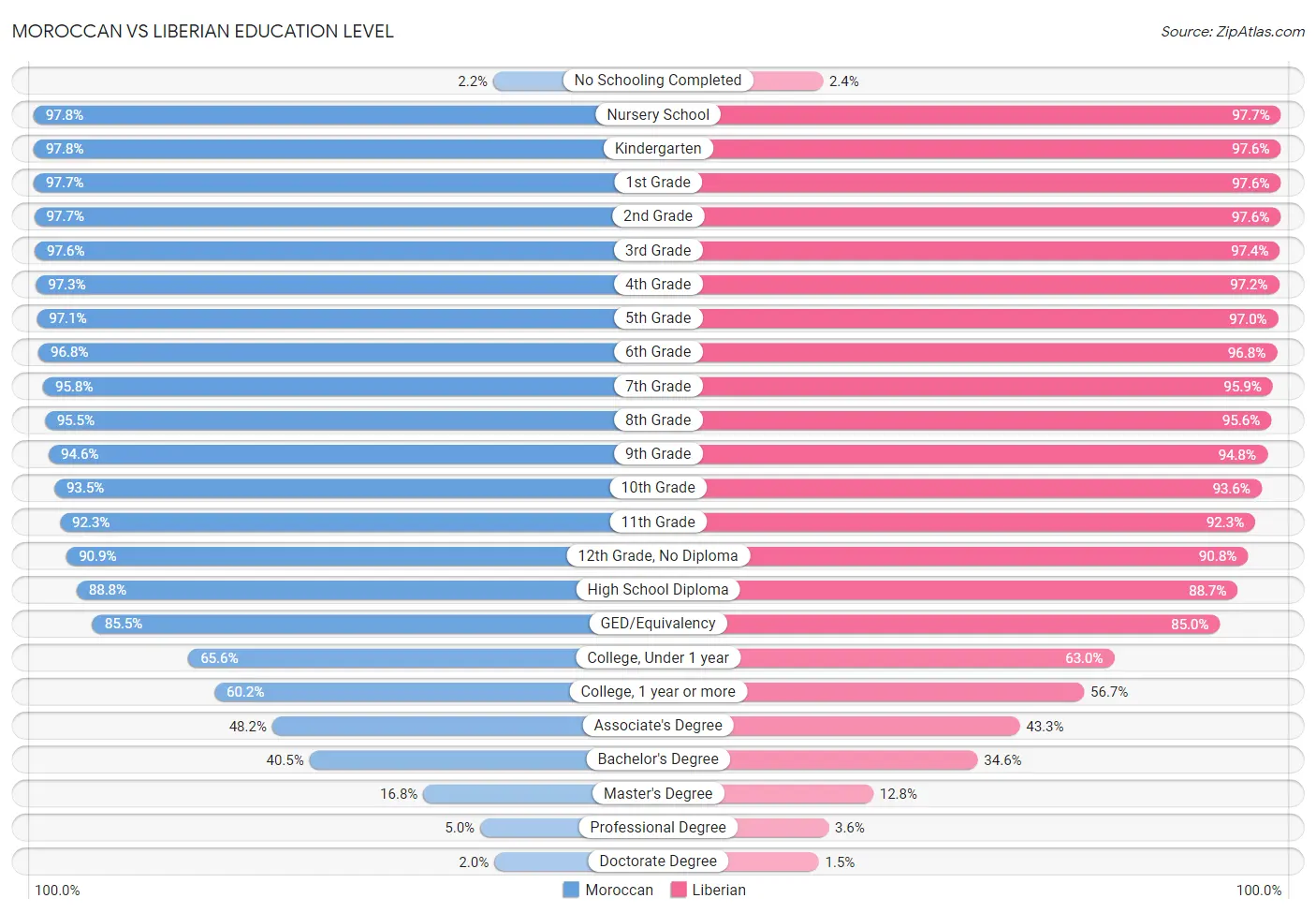
| Education Level Metric | Moroccan | Liberian |
| No Schooling Completed | Poor 2.2% | Tragic 2.4% |
| Nursery School | Tragic 97.8% | Tragic 97.7% |
| Kindergarten | Tragic 97.8% | Tragic 97.6% |
| 1st Grade | Tragic 97.7% | Tragic 97.6% |
| 2nd Grade | Tragic 97.7% | Tragic 97.6% |
| 3rd Grade | Tragic 97.6% | Tragic 97.4% |
| 4th Grade | Poor 97.3% | Tragic 97.2% |
| 5th Grade | Poor 97.1% | Tragic 97.0% |
| 6th Grade | Tragic 96.8% | Tragic 96.8% |
| 7th Grade | Poor 95.8% | Fair 95.9% |
| 8th Grade | Poor 95.5% | Fair 95.6% |
| 9th Grade | Poor 94.6% | Fair 94.8% |
| 10th Grade | Fair 93.5% | Fair 93.6% |
| 11th Grade | Fair 92.3% | Fair 92.3% |
| 12th Grade, No Diploma | Fair 90.9% | Poor 90.8% |
| High School Diploma | Fair 88.8% | Poor 88.7% |
| GED/Equivalency | Fair 85.5% | Poor 85.0% |
| College, Under 1 year | Average 65.6% | Tragic 63.0% |
| College, 1 year or more | Good 60.2% | Tragic 56.7% |
| Associate's Degree | Excellent 48.2% | Tragic 43.3% |
| Bachelor's Degree | Exceptional 40.5% | Tragic 34.6% |
| Master's Degree | Exceptional 16.8% | Tragic 12.8% |
| Professional Degree | Exceptional 5.0% | Tragic 3.6% |
| Doctorate Degree | Exceptional 2.0% | Tragic 1.5% |
Moroccan vs Liberian Disability
When considering disability, the most significant differences between Moroccan and Liberian communities in the United States are seen in disability age 35 to 64 (11.0% compared to 12.9%, a difference of 17.6%), disability age 18 to 34 (6.4% compared to 7.1%, a difference of 10.7%), and disability age 65 to 74 (23.3% compared to 25.6%, a difference of 10.1%). Conversely, both communities are more comparable in terms of hearing disability (2.8% compared to 2.8%, a difference of 1.6%), disability age over 75 (47.2% compared to 48.0%, a difference of 1.8%), and self-care disability (2.5% compared to 2.6%, a difference of 3.1%).
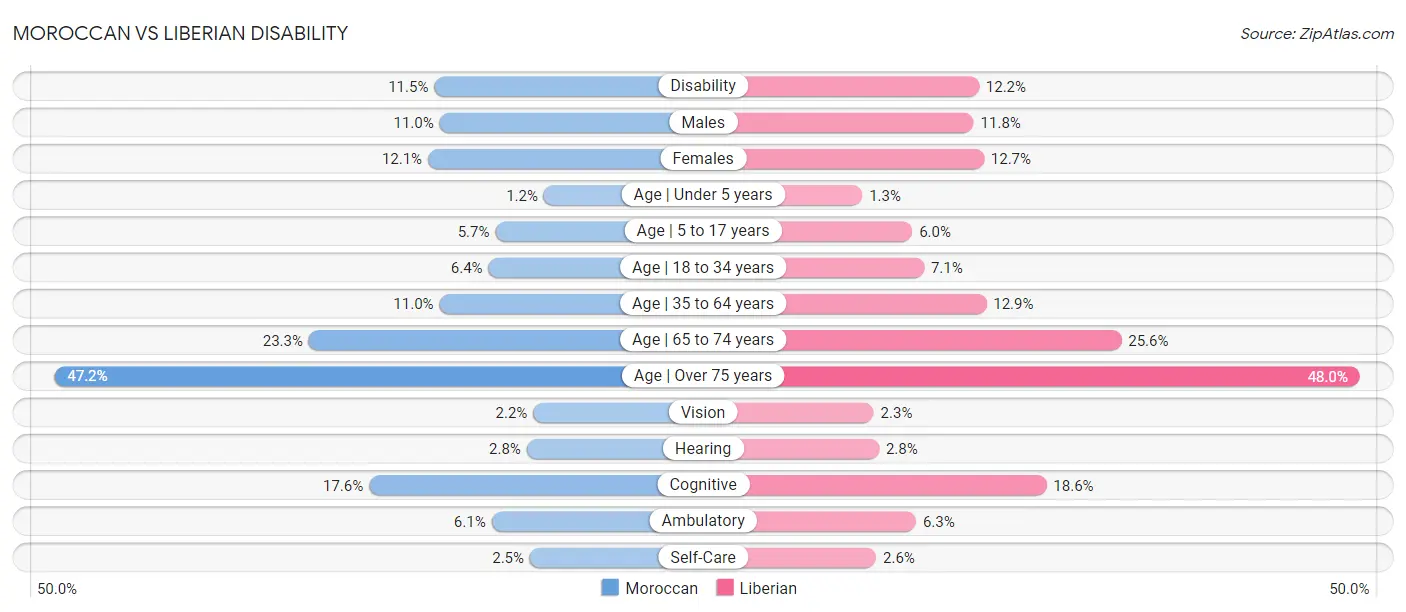
| Disability Metric | Moroccan | Liberian |
| Disability | Excellent 11.5% | Tragic 12.2% |
| Males | Excellent 11.0% | Tragic 11.8% |
| Females | Good 12.1% | Tragic 12.7% |
| Age | Under 5 years | Excellent 1.2% | Fair 1.3% |
| Age | 5 to 17 years | Poor 5.7% | Tragic 6.0% |
| Age | 18 to 34 years | Excellent 6.4% | Tragic 7.1% |
| Age | 35 to 64 years | Good 11.0% | Tragic 12.9% |
| Age | 65 to 74 years | Average 23.3% | Tragic 25.6% |
| Age | Over 75 years | Good 47.2% | Tragic 48.0% |
| Vision | Fair 2.2% | Tragic 2.3% |
| Hearing | Exceptional 2.8% | Excellent 2.8% |
| Cognitive | Tragic 17.6% | Tragic 18.6% |
| Ambulatory | Average 6.1% | Tragic 6.3% |
| Self-Care | Fair 2.5% | Tragic 2.6% |